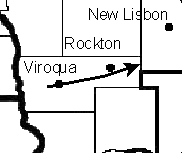On June 28, 1865 a tornado moved east from southwest of Viroqua, WI (devastating the southern part of that town) to south of Rockton before dissipating in a six-mile wide downburst near the Juneau County, WI line (Fig. 1). Multiple vortex "branches" and "eddies" were observed as the tornado passed through Viroqua around 4 pm. "Death rode upon that sulphury siroc" as "the angry elements at the beck of an invisible power lay waste the fairest portion of the village" (Glazulis, 1993). Ten people were killed on one street. A death total of 17 is usually given for this tornado, but according to the History of Vernon County at least 13 people were killed in Viroqua and as many as 12 others may have died later from injuries. There were approximately 100 injuries. The tornado was moving at an estimated 60 mph as it approached a schoolhouse 2 miles east of Viroqua containing a teacher and 24 students. The building was lifted into the air "and dashed to ground", killing the teacher and eight students. Foot-square timbers were carried "long distances; tree tops were filled with feather beds, chairs, and clothing. All kinds of livestock were either dead or writhing on the points of broken branches; 20-ton rocks were rolled, lifted, and broken" (Glazulis, 1993). Debris from Viroqua was found in New Lisbon, over 40 miles northeast of the city. The tornado was on the ground for 30 miles, with a width of 300 yards. Although this tornado does not have an official Fujita scale rating, based on the destruction it would likely be an F4. In addition, this is one of the earliest recorded tornadoes in Wisconsin history, and also one of the deadliest.
 |
| Fig 1. Approximate path of the June 28, 1965 tornado that struck Viroqua, WI. |
Another a tornado moved east along the Amherst/Holt Township line in Fillmore County, MN destroying four homes and damaging several others. The damage scene included "splinters, shingles, rails, and every conceivable article used about the farm or dwelling, together with shreds of torn garments, bed clothing, beds torn open and feathers filling the air like snow flakes" (Glazulis, 1993). In addition, chickens and turkeys were stripped of their feathers and lying dead in every direction.